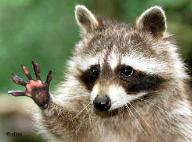
January 20, 2008
In 1934, Hermann Goering, then head of the Reich Forestry Office, gave permission for the release of a pair of common American raccoons (Procyon lotor) into the German wilderness to enrich the fauna. It has resulted in today’s furry blitzkrieg.
Due to the recent discussions here of raccoons in the Yucatan and escaped pet raccoons taking over Japan, I share revelant historical and contemporary highlights from a Deutsche Welle article about “Nazi” raccoons.
The link to the complete news item is at the end of this detailed overview of this alien invasion.

They’re actually American but feel right at home in Kassel, Germany, which has become the European raccoon capital since the animals were introduced here under the Third Reich.
The story begins in 1934, when a breeder asked the Reich Forestry Office, then led by future top Hitler aide Hermann Göring, for permission to release the masked-faced mammals to “enrich the local fauna” outside Kassel, a small city north of Frankfurt.
“Raccoon pelts were a popular trophy for hunters back then,” biologist Ulf Hohmann said. “They were also raised for their fur at special farms” after they were imported from North America early last century.
Seventy years on, the furry critters are now as populous in some areas of Germany as in the major urban centers of North America — a whopping one per hectare (2.5 acres), Hohmann said.
A raccoon’s urban paradise
Somewhere between 100,000 and one million raccoons are estimated to live in Germany, making them prime targets for hunters. Some 20,000 were shot during the last season, according to official statistics. But unfortunately for the denizens of a growing number of European capitals, they like cities.
Furry blitzkrieg?
Hundreds of thousands have fanned out to Belgium, Luxembourg, the Czech Republic and France. The news caught the ire of Britain’s Sun tabloid, which warned its readers that “Nazi raccoons” were “just across the Channel” and “on the warpath … in a furry blitzkrieg”.
[…snip…]
Since their introduction during the Third Reich, raccoons can trace their gradual conquest of Europe back to two other moments in history.
As Allied bombs rained over Berlin at the end of World War II, one struck a fur breeding farm, giving the raccoons there the opportunity to escape into the wild. They never looked back. And in the 1960s, NATO soldiers freed the raccoons they used as mascots after leaving their base in France, setting off a baby boom.
Hohmann says that in the coming years, raccoons are expected to spread to even more European cities.
“Kassel is just the beginning,” he said.
Source: “Nazi Raccoons on the March in Europe,” Deutsche Welle, September 11, 2004.
Also see an update: “From Nazi Past, a Proliferating Pest,” Washington Post, May 25, 2007.
About Loren Coleman
Loren Coleman is one of the world’s leading cryptozoologists, some say “the” leading living cryptozoologist. Certainly, he is acknowledged as the current living American researcher and writer who has most popularized cryptozoology in the late 20th and early 21st centuries.
Starting his fieldwork and investigations in 1960, after traveling and trekking extensively in pursuit of cryptozoological mysteries, Coleman began writing to share his experiences in 1969. An honorary member of Ivan T. Sanderson’s Society for the Investigation of the Unexplained in the 1970s, Coleman has been bestowed with similar honorary memberships of the North Idaho College Cryptozoology Club in 1983, and in subsequent years, that of the British Columbia Scientific Cryptozoology Club, CryptoSafari International, and other international organizations. He was also a Life Member and Benefactor of the International Society of Cryptozoology (now-defunct).
Loren Coleman’s daily blog, as a member of the Cryptomundo Team, served as an ongoing avenue of communication for the ever-growing body of cryptozoo news from 2005 through 2013. He returned as an infrequent contributor beginning Halloween week of 2015.
Coleman is the founder in 2003, and current director of the International Cryptozoology Museum in Portland, Maine.
Filed under Cryptomundo Exclusive, Cryptotourism, CryptoZoo News, Cryptozoologists, Cryptozoology, Out of Place, Year In Review